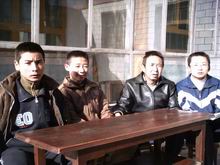Time: 15:00-16:30
Nov.20 2005
Interviewed at: Li Zhongde’s Home
Interviewee: Li Zhongde (Director
of Huangzhong County Museum)
Recorded by: Cao Yuanzhang, Ma Youzhong,
Li Yulong, Liu Zhanwen,Zhao Shengxiang
Q: What are the awards Ta’er Lamasery grand the monks? 
A: There are two kinds of awards: material and eternal title.
The former one including Buddha statues, sutras, pagodas, cassock,
waistcoat and money nearly covers every one in the monastery but
only generous and rich high-status living Buddhas can be granted
the latter one.
Q: Is it true that richer the living Buddhas and Lamas are, more
magnificent living place they can build?
A: No, not exactly. The red wall, green tiles, gold roof and precious
vases decorated their houses are sort of award and recognition
of their contributions to the monastery.
Q: What are the characteristics of the construction of Ta’er Lamasery?
A: The constructions are built along the mountains. Halls strew
at random, pagodas stand in great numbers and the monks’ dorms
lie closely, majestic and magnificent. And the constructions are
in styles combined with Tibet and Han.
Q: What is the Ta’er’s main contribution to local economy?
A: The road toward Ta’er is called Pagoda Road along which are
vendors selling various kinds of religious items attracting travelers
from home and abroad. Bazaar is so famous that it is entitled
one of the four largest markets of Tibetan goods together with
those in Beijing, Lasa and Chengdu. In recent years, the dealing
amount has reached tens of millions yuan and it contributed taxation
of millions.
Q: What is the origin of the title Dalai Lama?
A: In 1576, the chieftain of the Tumet tribe of the Mongols, Al-Than
Khan, whom the Ming Dynasty court had granted the honorific title
of Prince Shunyi, invited Soinam Gyamco, then 33, to lecture on
Buddhism in Qinghai. This made it possible for the Gelug Sect
to be widely worshipped among people of the Mongolian and Tibetan
ethnic groups in Qinghai. In 1578, the Mongol leader granted Soinam
Gyamco the honorific title of the Dalai Lama (Dalai meaning “ocean”
and Lama “superior man”), which was preceded by complex wording
meaning “omniscience” and “great authority”.
Q: Could you talk about the prayer dance?
A: It plays an important role in the Buddhist festivals. It is
a kind of special religious dance.
Q: What is Fawang Dance?
A: It is a kind of prayer dance. It has five parts. The first
part is skeleton dance. The second part is performed by 4 or 6
monks. The third part is deer dance. The fourth part is death
deity dance and the fifth is group dance and the audience take
part in it.
|



